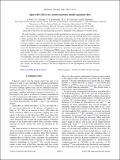| dc.contributor.author | Weiss, Sarah Avery | |
| dc.contributor.author | Rashba, Emmanuel | |
| dc.contributor.author | Kuemmeth, F | |
| dc.contributor.author | Churchill, H | |
| dc.contributor.author | Flensberg, K. | |
| dc.date.accessioned | 2016-01-07T20:16:07Z | |
| dc.date.issued | 2010 | |
| dc.identifier | Quick submit: 2015-12-30T11:26:58-05:00 | |
| dc.identifier.citation | Weiss, S., E. I. Rashba, F. Kuemmeth, H. O. H. Churchill, and K. Flensberg. 2010. “Spin-Orbit Effects in Carbon-Nanotube Double Quantum Dots.” Physical Review B 82 (16) (October 14). doi:10.1103/physrevb.82.165427. | en_US |
| dc.identifier.issn | 1098-0121 | en_US |
| dc.identifier.uri | http://nrs.harvard.edu/urn-3:HUL.InstRepos:24019817 | |
| dc.description.abstract | We study the energy spectrum of symmetric double quantum dots in narrow-gap carbon nanotubes with one and two electrostatically confined electrons in the presence of spin-orbit and Coulomb interactions. Compared to GaAs quantum dots, the spectrum exhibits a much richer structure because of the spin-orbit interaction that couples the electron’s isospin to its real spin through two independent coupling constants. In a single dot, both constants combine to split the spectrum into two Kramers doublets while the antisymmetric constant solely controls the difference in the tunneling rates of the Kramers doublets between the dots. For the two-electron regime, the detailed structure of the spin-orbit split energy spectrum is investigated as a function of detuning between the quantum dots in a 22-dimensional Hilbert space within the framework of a single-longitudinal-mode model. We find a competing effect of the tunneling and Coulomb interaction. The former favors a left-right symmetric two-particle ground state while in the regime where the Coulomb interaction dominates over tunneling, a left-right antisymmetric ground state is found. As a result, ground states on both sides of the (11)-(02) degeneracy point may possess opposite left-right symmetry, and the electron dynamics when tuning the system from one side of the (11)-(02) degeneracy point to the other is controlled by three selection rules (in spin, isospin, and left-right symmetry). We discuss implications for the spin-dephasing and Pauli blockade experiments. | en_US |
| dc.description.sponsorship | Physics | en_US |
| dc.language.iso | en_US | en_US |
| dc.publisher | American Physical Society (APS) | en_US |
| dc.relation.isversionof | doi:10.1103/physrevb.82.165427 | en_US |
| dc.relation.hasversion | http://arxiv.org/pdf/1006.0724v2.pdf | en_US |
| dash.license | LAA | |
| dc.title | Spin-orbit effects in carbon-nanotube double quantum dots | en_US |
| dc.type | Journal Article | en_US |
| dc.date.updated | 2015-12-30T16:26:58Z | |
| dc.description.version | Version of Record | en_US |
| dc.rights.holder | S. Weiss, E. I. Rashba, F. Kuemmeth, H. O. H. Churchill, and K. Flensberg | |
| dc.relation.journal | Phys. Rev. B | en_US |
| dash.depositing.author | Rashba, Emmanuel | |
| dc.date.available | 2016-01-07T20:16:07Z | |
| dc.identifier.doi | 10.1103/physrevb.82.165427 | * |
| dash.contributor.affiliated | Weiss, Sarah | |
| dash.contributor.affiliated | Churchill, Hugh Olen Hill | |
| dash.contributor.affiliated | Kuemmeth, Ferdinand | |
| dash.contributor.affiliated | Rashba, Emmanuel | |


